感官动词+doingto do
- 格式:doc
- 大小:25.00 KB
- 文档页数:1
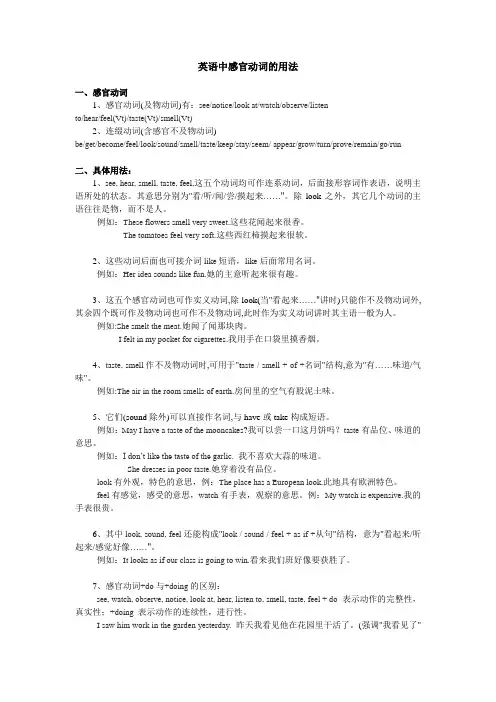
英语中感官动词的用法一、感官动词1、感官动词(及物动词)有:see/notice/look at/watch/observe/listento/hear/feel(Vt)/taste(Vt)/smell(Vt)2、连缀动词(含感官不及物动词)be/get/become/feel/look/sound/smell/taste/keep/stay/seem/ appear/grow/turn/prove/remain/go/run二、具体用法:1、see, hear, smell, taste, feel,这五个动词均可作连系动词,后面接形容词作表语,说明主语所处的状态。
其意思分别为"看/听/闻/尝/摸起来……"。
除look之外,其它几个动词的主语往往是物,而不是人。
例如:These flowers smell very sweet.这些花闻起来很香。
The tomatoes feel very soft.这些西红柿摸起来很软。
2、这些动词后面也可接介词like短语,like后面常用名词。
例如:Her idea sounds like fun.她的主意听起来很有趣。
3、这五个感官动词也可作实义动词,除look(当"看起来……"讲时)只能作不及物动词外,其余四个既可作及物动词也可作不及物动词,此时作为实义动词讲时其主语一般为人。
例如:She smelt the meat.她闻了闻那块肉。
I felt in my pocket for cigarettes.我用手在口袋里摸香烟。
4、taste, smell作不及物动词时,可用于"t aste / smell + of +名词"结构,意为"有……味道/气味"。
例如:The air in the room smells of earth.房间里的空气有股泥土味。
5、它们(sound除外)可以直接作名词,与have或take构成短语。
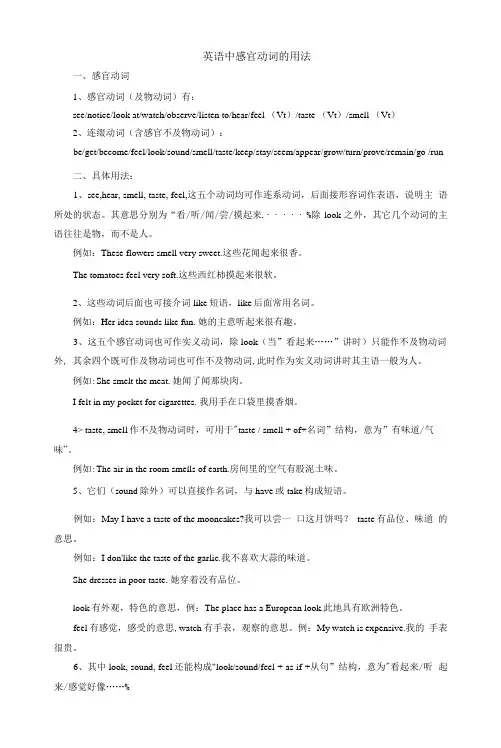
英语中感官动词的用法一、感官动词1、感官动词(及物动词)有:see/notice/look at/watch/observe/listen to/hear/feel (Vt)/taste (Vt)/smell (Vt)2、连缀动词(含感官不及物动词):be/get/become/feel/look/sound/smell/taste/keep/stay/seem/appear/grow/turn/prove/remain/go /run二、具体用法:1、see,hear, smell, taste, feel,这五个动词均可作连系动词,后面接形容词作表语,说明主语所处的状态。
其意思分别为“看/听/闻/尝/摸起来.・・・・・%除look之外,其它几个动词的主语往往是物,而不是人。
例如:These flowers smell very sweet.这些花闻起来很香。
The tomatoes feel very soft.这些西红柿摸起来很软。
2、这些动词后面也可接介词like短语,like后面常用名词。
例如:Her idea sounds like fun.她的主意听起来很有趣。
3、这五个感官动词也可作实义动词,除look(当”看起来……”讲时)只能作不及物动词外, 其余四个既可作及物动词也可作不及物动词,此时作为实义动词讲时其主语一般为人。
例如:She smelt the meat.她闻了闻那块肉。
I felt in my pocket for cigarettes.我用手在口袋里摸香烟。
4> taste, smell作不及物动词时,可用于"taste / smell + of+名词”结构,意为”有味道/气味”。
例如:The air in the room smells of earth.房间里的空气有股泥土味。
5、它们(sound除外)可以直接作名词,与have或take构成短语。
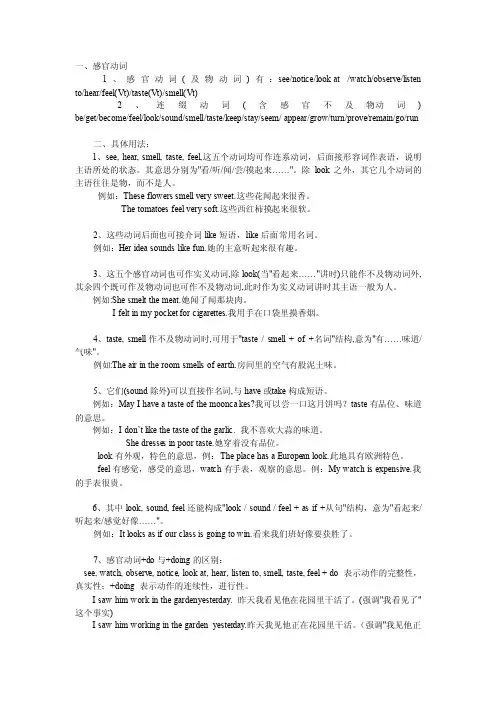
一、感官动词1、感官动词(及物动词)有:see/notice/look at/watch/observe/listento/hear/feel(Vt)/taste(Vt)/smell(Vt)2、连缀动词(含感官不及物动词) be/get/become/feel/look/sound/smell/taste/keep/stay/seem/ appear/grow/turn/prove/remain/go/run二、具体用法:1、see, hear, smell, taste, feel,这五个动词均可作连系动词,后面接形容词作表语,说明主语所处的状态。
其意思分别为"看/听/闻/尝/摸起来……"。
除look之外,其它几个动词的主语往往是物,而不是人。
例如:These flowers smell very sweet.这些花闻起来很香。
The tomatoe s feel very soft.这些西红柿摸起来很软。
2、这些动词后面也可接介词li ke短语,like后面常用名词。
例如:Her idea soundslike fun.她的主意听起来很有趣。
3、这五个感官动词也可作实义动词,除look(当"看起来……"讲时)只能作不及物动词外,其余四个既可作及物动词也可作不及物动词,此时作为实义动词讲时其主语一般为人。
例如:She smelt the meat.她闻了闻那块肉。
I felt in my pocketfor cigaret tes.我用手在口袋里摸香烟。
4、taste, smell作不及物动词时,可用于"taste / smell + of +名词"结构,意为"有……味道/气味"。
例如:The air in the room smellsof earth.房间里的空气有股泥土味。
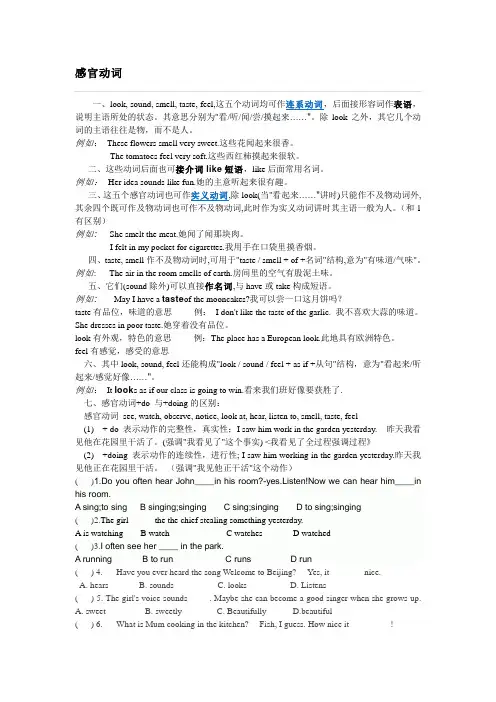
感官动词一、look, sound, smell, taste, feel,这五个动词均可作连系动词,后面接形容词作表语,说明主语所处的状态。
其意思分别为"看/听/闻/尝/摸起来……"。
除look之外,其它几个动词的主语往往是物,而不是人。
例如:These flowers smell very sweet.这些花闻起来很香。
The tomatoes feel very soft.这些西红柿摸起来很软。
二、这些动词后面也可接介词like短语,like后面常用名词。
例如:Her idea sounds like fun.她的主意听起来很有趣。
三、这五个感官动词也可作实义动词,除look(当"看起来……"讲时)只能作不及物动词外,其余四个既可作及物动词也可作不及物动词,此时作为实义动词讲时其主语一般为人。
(和1有区别)例如:She smelt the meat.她闻了闻那块肉。
I felt in my pocket for cigarettes.我用手在口袋里摸香烟。
四、taste, smell作不及物动词时,可用于"taste / smell + of +名词"结构,意为"有味道/气味"。
例如: The air in the room smells of earth.房间里的空气有股泥土味。
五、它们(sound除外)可以直接作名词,与have或take构成短语。
例如:May I have a taste of the mooncakes?我可以尝一口这月饼吗?taste有品位,味道的意思例:I don't like the taste of the garlic. 我不喜欢大蒜的味道。
She dresses in poor taste.她穿着没有品位。
look有外观,特色的意思例:The place has a European look.此地具有欧洲特色。
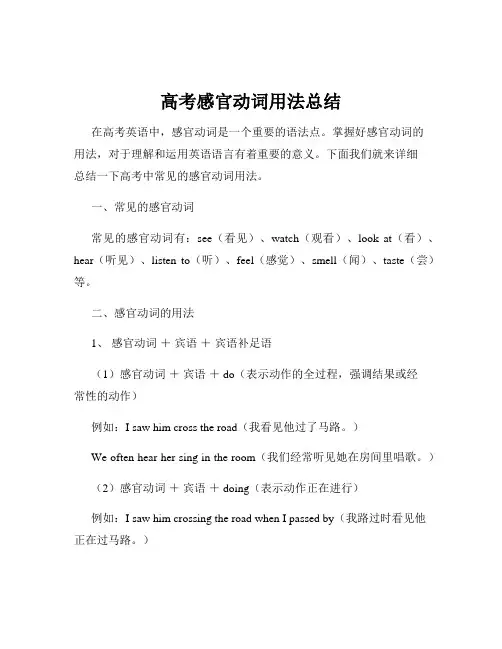
高考感官动词用法总结在高考英语中,感官动词是一个重要的语法点。
掌握好感官动词的用法,对于理解和运用英语语言有着重要的意义。
下面我们就来详细总结一下高考中常见的感官动词用法。
一、常见的感官动词常见的感官动词有:see(看见)、watch(观看)、look at(看)、hear(听见)、listen to(听)、feel(感觉)、smell(闻)、taste(尝)等。
二、感官动词的用法1、感官动词+宾语+宾语补足语(1)感官动词+宾语+ do(表示动作的全过程,强调结果或经常性的动作)例如:I saw him cross the road(我看见他过了马路。
)We often hear her sing in the room(我们经常听见她在房间里唱歌。
)(2)感官动词+宾语+ doing(表示动作正在进行)例如:I saw him crossing the road when I passed by(我路过时看见他正在过马路。
)I heard her singing in the room at that time(那时我听见她正在房间里唱歌。
)(3)感官动词+宾语+ done(表示宾语与宾语补足语之间是被动关系)例如:I saw the window broken(我看见窗户被打破了。
)We found the tree cut down(我们发现树被砍倒了。
)2、感官动词+宾语从句例如:I saw that he crossed the road safely(我看见他安全地过了马路。
)She heard that someone was knocking at the door(她听见有人在敲门。
)3、感官动词的被动语态感官动词在被动语态中,其后的宾语补足语要用带 to 的不定式。
例如:He was seen to cross the road(有人看见他过了马路。
)The girl was heard to sing in the room(有人听见这个女孩在房间里唱歌。
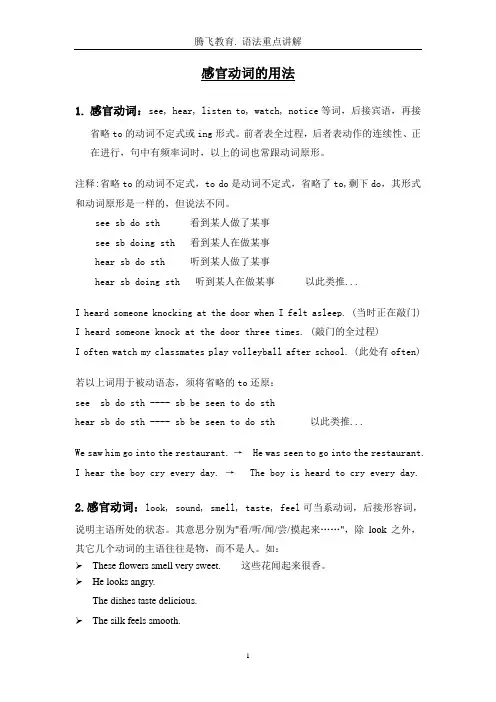
感官动词的用法1.感官动词:see, hear, listen to, watch, notice等词,后接宾语,再接省略to的动词不定式或ing形式。
前者表全过程,后者表动作的连续性、正在进行,句中有频率词时,以上的词也常跟动词原形。
注释:省略to的动词不定式,to do是动词不定式,省略了to,剩下do,其形式和动词原形是一样的,但说法不同。
see sb do sth 看到某人做了某事see sb doing sth 看到某人在做某事hear sb do sth 听到某人做了某事hear sb doing sth 听到某人在做某事以此类推...I heard someone knocking at the door when I felt asleep. (当时正在敲门) I heard someone knock at the door three times. (敲门的全过程)I often watch my classmates play volleyball after school. (此处有often)若以上词用于被动语态,须将省略的to还原:see sb do sth ---- sb be seen to do sthhear sb do sth ---- sb be seen to do sth 以此类推...We saw him go into the restaurant. → He was seen to go into the restaurant.I hear the boy cry every day. → The boy is heard to cry every day.2.感官动词:look, sound, smell, taste, feel可当系动词,后接形容词,说明主语所处的状态。
其意思分别为"看/听/闻/尝/摸起来……",除look之外,其它几个动词的主语往往是物,而不是人。
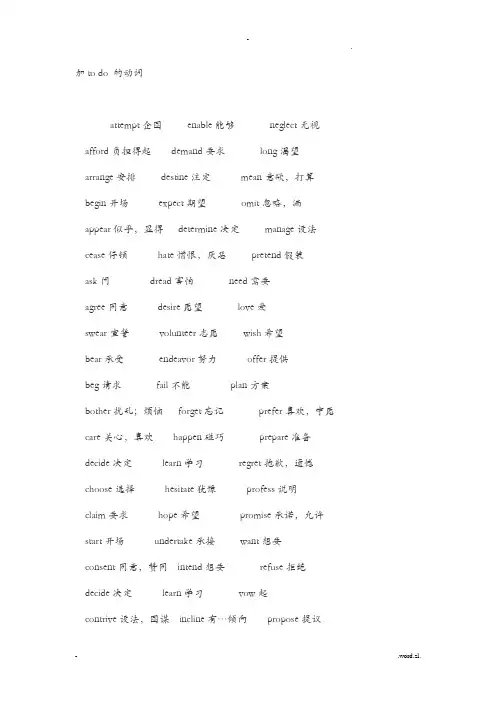
加to do 的动词attempt企图enable能够neglect无视afford负担得起demand要求long渴望arrange安排destine注定mean意欲,打算begin开场expect期望omit忽略,漏appear似乎,显得determine决定manage设法cease停顿hate憎恨,厌恶pretend假装ask问dread害怕need需要agree同意desire愿望love爱swear宣誓volunteer志愿wish希望bear承受endeavor努力offer提供beg请求fail不能plan方案bother扰乱;烦恼forget忘记prefer喜欢,宁愿care关心,喜欢happen碰巧prepare准备decide决定learn学习regret抱歉,遗憾choose选择hesitate犹豫profess说明claim要求hope希望promise承诺,允许start开场undertake承接want想要consent同意,赞同intend想要refuse拒绝decide决定learn学习vow起contrive设法,图谋incline有…倾向propose提议seek找,寻觅try试图2)下面的动词要求不定式做宾补:动词+宾语+动词不定式ask要求,邀请get请,得到prompt促使allow允许forbid制止prefer喜欢,宁愿announce宣布force强迫press迫使bride 收买inspire鼓舞request请求assist协助hate憎恶pronounce断定,表示advise劝告exhort告诫,勉励pray请求authorize授权,委托help帮助recommend劝告,推荐bear容忍implore恳求remind提醒beg请求induce引诱report报告compel强迫invite吸引,邀请,summon传唤command命令intend想要,企图show 显示drive驱赶mean意欲,打算train训练cause引起instruct指示require要求deserve应受leave使,让tell告诉direct指导like喜欢tempt劝诱entitle有资格order命令warn告诫enable使能够need需要urge鼓励,力说encourage鼓励oblige不得不want想要condemn指责,谴责lead引起,使得teach教entreat恳求permit允许wish希望(2)有少数动词只能用动名词作宾语acknowledge成认,自认cease 停顿mention说到,讲到admit 成认tolerate忍受dislike不喜欢,讨厌advocate:提倡,主complete完成dread可怕appreciate 感谢,欣赏confess坦白endure忍受avoid防止contemplate细想enjoy享有,喜爱bear忍受defer拖延envy嫉妒can’t help不禁delay延迟escape逃跑,逃避can’t stand受不了deny否认excuse借口consider 考虑detest嫌恶fancy梦想,爱好favor 造成,偏爱mind 介意repent悔悟figure描绘,计算miss错过resent怨恨finish完成,完毕不得pardon原谅,饶恕resist抵抗,阻止forgive原谅permit 允许resume恢复imagine设想postpone延迟,延期risk冒险involve卷入,包含practise 实行,实践suggest建议hate讨厌prevent阻止save营救,储蓄keep保持quit放弃停顿stand坚持,忍受loathe非常讨厌,厌恶recall回想例如:I appreciate having been given the opportunity to study abroad two years ago.我很感谢两年前给我出国学习的时机。
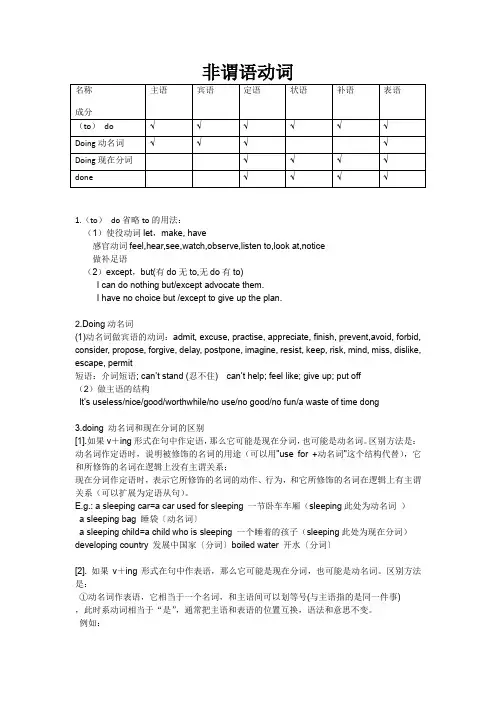
非谓语动词1.(to)do省略to的用法:(1)使役动词let,make, have感官动词feel,hear,see,watch,observe,listen to,look at,notice做补足语(2)except,but(有do无to,无do有to)I can do nothing but/except advocate them.I have no choice but /except to give up the plan.2.Doing动名词(1)动名词做宾语的动词:admit, excuse, practise, appreciate, finish, prevent,avoid, forbid, consider, propose, forgive, delay, postpone, imagine, resist, keep, risk, mind, miss, dislike, escape, permit短语:介词短语; can’t stand (忍不住) can’t help; feel like; give up; put off(2)做主语的结构It’s useless/nice/good/worthwhile/no use/no good/no fun/a waste of time dong3.doing 动名词和现在分词的区别[1].如果v+ing形式在句中作定语,那么它可能是现在分词,也可能是动名词。
区别方法是:动名词作定语时,说明被修饰的名词的用途(可以用"use for +动名词"这个结构代替),它和所修饰的名词在逻辑上没有主谓关系;现在分词作定语时,表示它所修饰的名词的动作、行为,和它所修饰的名词在逻辑上有主谓关系(可以扩展为定语从句)。
E.g.: a sleeping car=a car used for sleeping 一节卧车车厢(sleeping此处为动名词)a sleeping bag 睡袋〔动名词〕a sleeping child=a child who is sleeping 一个睡着的孩子(sleeping此处为现在分词)developing country 发展中国家〔分词〕boiled water 开水〔分词〕[2]. 如果v+ing形式在句中作表语,那么它可能是现在分词,也可能是动名词。
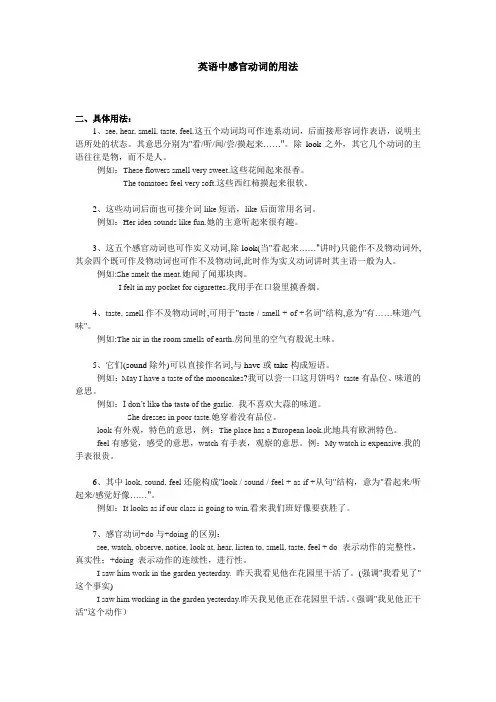
英语中感官动词的用法二、具体用法:1、see, hear, smell, taste, feel,这五个动词均可作连系动词,后面接形容词作表语,说明主语所处的状态。
其意思分别为"看/听/闻/尝/摸起来……"。
除look之外,其它几个动词的主语往往是物,而不是人。
例如:These flowers smell very sweet.这些花闻起来很香。
The tomatoes feel very soft.这些西红柿摸起来很软。
2、这些动词后面也可接介词like短语,like后面常用名词。
例如:Her idea sounds like fun.她的主意听起来很有趣。
3、这五个感官动词也可作实义动词,除look(当"看起来……"讲时)只能作不及物动词外,其余四个既可作及物动词也可作不及物动词,此时作为实义动词讲时其主语一般为人。
例如:She smelt the meat.她闻了闻那块肉。
I felt in my pocket for cigarettes.我用手在口袋里摸香烟。
4、taste, smell作不及物动词时,可用于"t aste / smell + of +名词"结构,意为"有……味道/气味"。
例如:The air in the room smells of earth.房间里的空气有股泥土味。
5、它们(sound除外)可以直接作名词,与have或take构成短语。
例如:May I have a taste of the mooncakes?我可以尝一口这月饼吗?taste有品位、味道的意思。
例如:I don’t like the taste of the garlic.我不喜欢大蒜的味道。
She dresses in poor taste.她穿着没有品位。
look有外观,特色的意思,例:The place has a European look.此地具有欧洲特色。
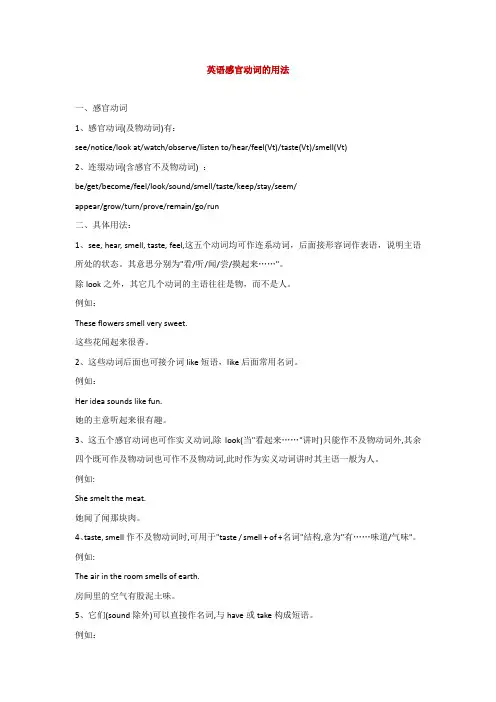
英语感官动词的用法一、感官动词1、感官动词(及物动词)有:see/notice/look at/watch/observe/listen to/hear/feel(Vt)/taste(Vt)/smell(Vt)2、连缀动词(含感官不及物动词) :be/get/become/feel/look/sound/smell/taste/keep/stay/seem/appear/grow/turn/prove/remain/go/run二、具体用法:1、see, hear, smell, taste, feel,这五个动词均可作连系动词,后面接形容词作表语,说明主语所处的状态。
其意思分别为"看/听/闻/尝/摸起来……"。
除look之外,其它几个动词的主语往往是物,而不是人。
例如:These flowers smell very sweet.这些花闻起来很香。
2、这些动词后面也可接介词like短语,like后面常用名词。
例如:Her idea sounds like fun.她的主意听起来很有趣。
3、这五个感官动词也可作实义动词,除look(当"看起来……"讲时)只能作不及物动词外,其余四个既可作及物动词也可作不及物动词,此时作为实义动词讲时其主语一般为人。
例如:She smelt the meat.她闻了闻那块肉。
4、taste, smell作不及物动词时,可用于"taste / smell + of +名词"结构,意为"有……味道/气味"。
例如:The air in the room smells of earth.房间里的空气有股泥土味。
5、它们(sound除外)可以直接作名词,与have或take构成短语。
例如:May I have a taste of the mooncakes?我可以尝一口这月饼吗?taste有品位、味道的意思。
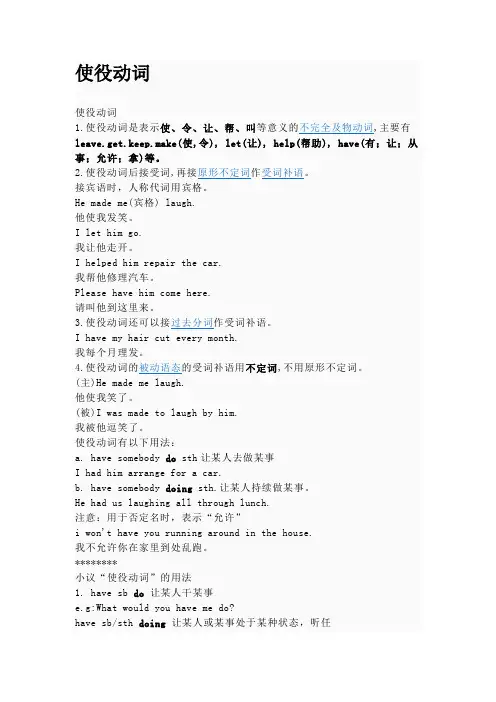
使役动词使役动词1.使役动词是表示使、令、让、帮、叫等意义的不完全及物动词,主要有leave.get.keep.make(使,令), let(让), help(帮助), have(有;让;从事;允许;拿)等。
2.使役动词后接受词,再接原形不定词作受词补语。
接宾语时,人称代词用宾格。
He made me(宾格) laugh.他使我发笑。
I let him go.我让他走开。
I helped him repair the car.我帮他修理汽车。
Please have him come here.请叫他到这里来。
3.使役动词还可以接过去分词作受词补语。
I have my hair cut every month.我每个月理发。
4.使役动词的被动语态的受词补语用不定词,不用原形不定词。
(主)He made me laugh.他使我笑了。
(被)I was made to laugh by him.我被他逗笑了。
使役动词有以下用法:a. have somebody do sth让某人去做某事I had him arrange for a car.b. have somebody doing sth.让某人持续做某事。
He had us laughing all through lunch.注意:用于否定名时,表示“允许”i won't have you running around in the house.我不允许你在家里到处乱跑。
********小议“使役动词”的用法1. have sb do让某人干某事e.g:What would you have me do?have sb/sth doing 让某人或某事处于某种状态,听任e.g: I won't have women working in our company.The two cheats had the light burning all night long.have sth done让别人干某事,遭受到e.g:you 'd better have your teeth pulled out.He had his pocket picked.notes: "done"这个动作不是主语发出来的。
感官动词1、感官动词(及物动词)有:see/notice/look at/watch/observe/listen to/hear/feel(Vt)/taste(Vt)/smell(Vt)2、连缀动词(含感官不及物动词) be/get/become/feel/look/sound/smell/taste/keep/stay/seem/ appear/grow/turn/prove/remain/go/run二、具体用法:1、see, hear, smell, taste, feel,这五个动词均可作连系动词,后面接形容词作表语,说明主语所处的状态。
其意思分别为"看/听/闻/尝/摸起来……"。
除look之外,其它几个动词的主语往往是物,而不是人。
例如:These flowers smell very sweet.这些花闻起来很香。
The tomatoes feel very soft.这些西红柿摸起来很软。
2、这些动词后面也可接介词like短语,like后面常用名词。
例如:Her idea sounds like fun.她的主意听起来很有趣。
3、这五个感官动词也可作实义动词,除look(当"看起来……"讲时)只能作不及物动词外,其余四个既可作及物动词也可作不及物动词,此时作为实义动词讲时其主语一般为人。
例如:She smelt the meat.她闻了闻那块肉。
I felt in my pocket for cigarettes.我用手在口袋里摸香烟。
4、taste, smell作不及物动词时,可用于"taste / smell + of +名词"结构,意为"有……味道/气味"。
例如:The air in the room smells of earth.房间里的空气有股泥土味。
5、它们(sound除外)可以直接作名词,与have或take构成短语。
1) 加to do 的动词attempt企图neglect忽视afford负担得起demand要求long渴望arrange安排destine注定mean意欲,打算begin开始expect期望omit忽略,漏appear似乎,显得determine决定manage设法hate憎恨,厌恶pretend假装ask问dread害怕need需要agree同意desire愿望love爱swear宣誓volunteer志愿wish希望bear承受offer提供beg请求fail不能plan计划bother扰乱;烦恼forget忘记prefer喜欢,宁愿care关心,喜欢happen碰巧prepare准备decide决定learn学习regret抱歉,遗憾choose选择hesitate犹豫profess表明claim要求hope希望promise承诺,允许start开始undertake承接want想要consent同意,赞同intend想要refuse拒绝decide决定learn学习propose提议seek找,寻觅try试图aim demand desire elect help tend expect例如:The driver failed to see the other car in time. 司机没能及时看见另一辆车。
He offered to help me. 他表示愿意帮助我。
2)下面的动词要求不定式做宾补:动词+宾语+动词不定式ask要求,邀请get请,得到prompt促使allow允许forbid禁止prefer喜欢,宁愿announce宣布force强迫press迫使bride 收买inspire鼓舞request请求assist协助hate憎恶pronounce断定,表示advise劝告exhort告诫,勉励pray请求authorize授权,委托help帮助recommend劝告,推荐bear容忍implore恳求remind提醒beg请求induce引诱report报告compel强迫invite吸引,邀请,summon传唤command命令intend想要,企图show 显示drive驱赶mean意欲,打算train训练cause引起instruct指示require要求deserve应受leave使,让tell告诉direct指导like喜欢tempt劝诱entitle有资格order命令warn告诫enable使能够need需要urge激励,力说encourage鼓励oblige不得不want想要condemn指责,谴责lead引起,使得teach教entreat恳求permit允许wish希望3)加doing的动词acknowledge承认,自认cease 停止mention说到,讲到admit 承认tolerate忍受dislike不喜欢,讨厌advocate:提倡,主张complete完成dread可怕appreciate 感激,欣赏confess坦白endure忍受avoid避免contemplate细想enjoy享有,喜爱bear忍受defer拖延envy嫉妒can’t help不禁delay延迟escape逃跑,逃避can’t stand受不了deny否认excuse借口consider 考虑detest嫌恶fancy幻想,爱好favor 造成,偏爱mind 介意repent悔悟figure描绘,计算miss错过resent怨恨finish完成,结束不得pardon原谅,饶恕resist抵抗,阻止forgive原谅permit 允许resume恢复imagine设想postpone延迟,延期risk冒险involve卷入,包含practise 实行,实践suggest建议hate讨厌prevent阻止save营救,储蓄keep保持quit放弃停止stand坚持,忍受loathe非常讨厌,厌恶recall回想例如:I appreciate having been given the opportunity to study abroad two years ago.我很感激两年前给我出国学习的机会。
感官动词和使役动词语法详解一、感官动词1、see, hear, feel, watch, l ook, catch, notice, find, listen to, smell, seem, taste等感官动词后可接d o或d oing。
后接动词原形(do)表示动作的完整性,真实性;+d oing 表示动作的连续性,进行性。
I saw him work in the gard en yesterday.昨天我看见他在花园里干活了。
(强调“我看见了”这个事实)I saw him working in the gard en. (强调“我见他正干活”这个动作) 我看见他正在花园里干活。
★感官动词中sound, feel, l ook, smell, taste还可以做系动词,后可接形容词。
This soup tastes d elicious. The id ea sounds great.This cl oth feels soft. She l ooks beautiful in red.The fl owers smell sweet.2、使役动词使役动词是表示使、令、让、帮、叫等意义的动词,主要有make (使,令),l et (让),help (帮助),have (叫),get 等。
(1)役动词make, l et后可以接动词原形,表示让某人做某事。
He mad e me (宾格) laugh.他使我发笑。
注意:变为被动语态时,要加上to:I was mad e to laugh by him.(2)使役动词get的结构为:get +宾语+ to d o,表示让某人做某事。
例:The teacher mad e John copy the lesson ten times.= The teacher had John copy the lesson ten times.= The teacher got John to copy the lesson ten times.例:I had him mend my watch.= I got him to mend my watch.(3)help的常用结构为:help sb (to) d o sth / help sb with sth例:He helps me to study Chinese.Mary helps him with his pronunciation.(4)have做使役动词的用法1). have somebody d o sth让某人去做某事I had him arrange for a car.2). have somebody d oing sth.让某人持续做某事。
非谓语的时态不定式to do/ to be done/to be doing/to have done/to have been doneI plan to attend the meeting to be held tomorrow.The students pretended to be doing their homework when the teacher came in. He is believed to be coming.(表将来)He is believed to have come.The novel is believed to have been translated into Chinese.现在分词doing/being done/having done/having been doneThe man standing at the window is our teacher.Being a student, he was interested in books.The question being discussed is important.Having studied in the university for 3 years, he knows the place very well. Having been criticized by the teacher, he gave up smoking.过去分词doneThe teacher stood there surrounded by the students.非谓语作状语不定式作状语不定式表目的Helen had to shout to make herself heard above the sound of music.不定式表“意外或事与愿违”的结果He hurried to the station only to find that the train had left.表示情感、情绪的形容词作表语,后接不定式表原因I’m very glad to see you.I’m so sorry to hear about your failure in business.be + adj. + to do(不定式作表语形容词的状语,与主语构成动宾关系,不定式用主动形式,因为通常认为形容词后省略了for one/for people)The book is difficult to understand.English is easy to learn.分词作状语(分词主语与主句一致)v-ing作状语(主动,同时)Be careful when crossing the street. 过马路时要小心。
感官动词的用法1.感官动词:see, hear, listen to, watch, notice等词,后接宾语,再接省略to的动词不定式或ing形式。
前者表全过程,后者表动作的连续性、正在进行,句中有频率词时,以上的词也常跟动词原形。
注释:省略to的动词不定式,to do是动词不定式,省略了to,剩下do,其形式和动词原形是一样的,但说法不同。
see sb do sth 看到某人做了某事see sb doing sth 看到某人在做某事hear sb do sth 听到某人做了某事hear sb doing sth 听到某人在做某事以此类推...I heard someone knocking at the door when I felt asleep. (当时正在敲门) I heard someone knock at the door three times. (敲门的全过程)I often watch my classmates play volleyball after school. (此处有often)若以上词用于被动语态,须将省略的to还原:see sb do sth ---- sb be seen to do sthhear sb do sth ---- sb be seen to do sth 以此类推...We saw him go into the restaurant. → He was seen to go into the restaurant.I hear the boy cry every day. → The boy is heard to cry every day.2.感官动词:look, sound, smell, taste, feel可当系动词,后接形容词,说明主语所处的状态。
其意思分别为"看/听/闻/尝/摸起来……",除look之外,其它几个动词的主语往往是物,而不是人。
感官动词 see, watch, observe, notice, look at, hear, listen to, smell, taste, feel
+ do 表示动作的完整性,真实性;+doing 表示动作的连续性,进行性
I saw him work in the garden yesterday.
昨天我看见他在花园里干活了。(强调"我看见了"这个事实)
I saw him working in the garden yesterday.(强调"我见他正干活"这个动作)
昨天我见他正在花园里干活。
典型例题
1)They knew her very well. They had seen her ___ up from childhood.
A. grow B. grew C. was growing D. to grow
答案:A。因题意为,他们看着她长大,因此强调的是成长的过程,而非正在长的动作,
因此用see sb do sth 的句型。
2)The missing boy was last seen ___ near the river.
A. playing B. to be playing C. play D. to play
答案A. 本题强调其动作,正在河边玩,应此用see sb. doing sth句型